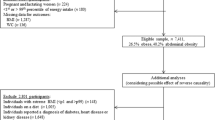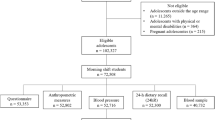Abstract
Background/objectives:
Despite the worldwide scientific and media attention, the actual fructose consumption in many non-US populations is not clear. The aim of this study was to estimate the fructose consumption and its main food sources in a representative sample of the general Dutch population.
Subjects/methods:
In all, 3817 children and adults aged 7–69 years from the Dutch National Food Consumption Survey 2007–2010 were studied. Values for fructose content of the products were assigned using several food composition tables. Diet was assessed with two nonconsecutive 24-h dietary recalls. The Multiple Source Method was used to take into account day-to-day variation and to estimate the habitual fructose consumption.
Results:
Median habitual fructose intake was 46 g/day, with an interquartile range of 35–60 g/day. In boys, the highest median intake was observed among 14- to 18-year olds: 61 g/day. In girls, those aged 9–13 years reported the highest median intake: 56 g/day. Of total fructose intake, 67% was consumed in the form of sucrose and 33% was consumed as free fructose. Soft drinks constituted the main food source of total fructose (13–29% across age and sex categories), followed by juices (9–12%), fruit (9–18%), cake and cookies (9–11%) and dairy products (6–10%).
Conclusions:
Fructose comprised 9% of the mean daily energy intake in the general Dutch population aged 7–69 years. The fructose consumption was somewhat lower than most recent figures from the US. The main food sources of fructose were soft drinks, juices and fruit.
This is a preview of subscription content, access via your institution
Access options
Subscribe to this journal
Receive 12 print issues and online access
$259.00 per year
only $21.58 per issue
Buy this article
- Purchase on Springer Link
- Instant access to full article PDF
Prices may be subject to local taxes which are calculated during checkout


Similar content being viewed by others
References
Bray GA, Nielsen SJ, Popkin BM . Consumption of high-fructose corn syrup in beverages may play a role in the epidemic of obesity. Am J Clin Nutr 2004; 79: 537–543.
Lustig RH, Schmidt LA, Brindis CD . Public health: the toxic truth about sugar. Nature 2012; 482: 27–29.
Rippe JM . The metabolic and endocrine response and health implications of consuming sugar-sweetened beverages: findings from recent randomized controlled trials. Adv Nutr 2013; 4: 677–686.
Tappy L, Le KA . Does fructose consumption contribute to non-alcoholic fatty liver disease? Clin Res Hepatol Gastroenterol 2012; 36: 554–560.
Chiu S, Sievenpiper JL, de Souza RJ, Cozma AI, Mirrahimi A, Carleton AJ et al. Effect of fructose on markers of non-alcoholic fatty liver disease (NAFLD): a systematic review and meta-analysis of controlled feeding trials. Eur J Clin Nutr 2014; 68: 416–423.
Ha V, Sievenpiper JL, de Souza RJ, Chiavaroli L, Wang DD, Cozma AI et al. Effect of fructose on blood pressure: a systematic review and meta-analysis of controlled feeding trials. Hypertension 2012; 59: 787–795.
Sievenpiper JL, de Souza RJ, Mirrahimi A, Yu ME, Carleton AJ, Beyene J et al. Effect of fructose on body weight in controlled feeding trials: a systematic review and meta-analysis. Ann Intern Med 2012; 156: 291–304.
David Wang D, Sievenpiper JL, de Souza RJ, Cozma AI, Chiavaroli L, Ha V et al. Effect of fructose on postprandial triglycerides: A systematic review and meta-analysis of controlled feeding trials. Atherosclerosis 2014; 232: 125–133.
Sun SZ, Anderson GH, Flickinger BD, Williamson-Hughes PS, Empie MW . Fructose and non-fructose sugar intakes in the US population and their associations with indicators of metabolic syndrome. Food Chem Toxicol 2011; 49: 2875–2882.
van Buul VJ, Tappy L, Brouns FJ . Misconceptions about fructose-containing sugars and their role in the obesity epidemic. Nutr Res Rev 2014; 27: 119–130.
Bray GA . Energy and fructose from beverages sweetened with sugar or high-fructose corn syrup pose a health risk for some people. Adv Nutr 2013; 4: 220–225.
Hu FB . Resolved: there is sufficient scientific evidence that decreasing sugar-sweetened beverage consumption will reduce the prevalence of obesity and obesity-related diseases. Obes Rev 2013; 14: 606–619.
Official Journal of the European Union L347. Regulation (EU) No 1308/2013 of the European parliament and of the council of 17 December 2013 establishing a common organisation of the markets in agricultural products and repealing Council Regulations (EEC) No 922/72, (EEC) No 234/79, (EC) No 1037/2001 and (EC) No 1234/2007 2013, p. 838.
van Rossum CTM, Fransen HP, Verkaik-Kloosterman J, Buurma-Rethans EJM, Ocké MC . Dutch National Food Consumption Survey 2007-2010. Diet of children and adults 7 to 69 years.. RIVM: Bilthoven, 2011, RIVM-Report 350050006.
NEVO-online versie 2011/3.0. National Institute for Public Health and the Environment (RIVM), 2011.
Food Standards Agency. McCance and Widdowson's composition of foods: integrated dataset 2002, Available at http://www.food.gov.uk/multimedia/pdfs/cofuserdoc.pdf (accessed 22 January 2014).
Saxholt E, Christensen AT, Møller A, Hartkopp HB, Hess Ygil K, Hels OH . Danish Food Composition Databank, revision 7. Department of Nutrition, National Food Institute. Technical University of Denmark, 2008; 2008.
National Institute for Health and Welfare. Fineli. Finnish food composition database. Release 14. Helsinki. www.fineli.fi.
Slimani N, Deharveng G, Charrondiere RU, van Kappel AL, Ocke MC, Welch A et al. Structure of the standardized computerized 24-h diet recall interview used as reference method in the 22 centers participating in the EPIC project. European Prospective Investigation into Cancer and Nutrition. Comput Methods Programs Biomed 1999; 58: 251–266.
Slimani N, Ferrari P, Ocke M, Welch A, Boeing H, Liere M et al. Standardization of the 24-hour diet recall calibration method used in the european prospective investigation into cancer and nutrition (EPIC): general concepts and preliminary results. Eur J Clin Nutr 2000; 54: 900–917.
Harttig U, Haubrock J, Knuppel S, Boeing H, Consortium E . The MSM program: web-based statistics package for estimating usual dietary intake using the Multiple Source Method. Eur J Clin Nutr 2011; 65(Suppl 1): S87–S91.
Haubrock J, Nothlings U, Volatier JL, Dekkers A, Ocke M, Harttig U et al. Estimating usual food intake distributions by using the multiple source method in the EPIC-Potsdam Calibration Study. J Nutr 2011; 141: 914–920.
Schaefer EJ, Gleason JA, Dansinger ML . Dietary fructose and glucose differentially affect lipid and glucose homeostasis. J Nutr 2009; 139: 1257S–1262SS.
Zhang YH, An T, Zhang RC, Zhou Q, Huang Y, Zhang J . Very high fructose intake increases serum LDL-cholesterol and total cholesterol: a meta-analysis of controlled feeding trials. J Nutr 2013; 143: 1391–1398.
Vos MB, Kimmons JE, Gillespie C, Welsh J, Blanck HM . Dietary fructose consumption among US children and adults: the Third National Health and Nutrition Examination Survey. Medscape J Med 2008; 10: 160.
University of Otago and Ministry of Health A Focus on Nutrition: Key findings of the 2008/09 New Zealand Adult Nutrition Survey. Ministry of Health: Wellington, 2011.
Chung M, Ma J, Patel K, Berger S, Lau J, Lichtenstein AH . Fructose, high-fructose corn syrup, sucrose, and nonalcoholic fatty liver disease or indexes of liver health: a systematic review and meta-analysis. Am J Clin Nutr 2014; 100: 833–849.
van Buul VJ, Tappy L, Brouns FJ . Misconceptions about fructose-containing sugars and their role in the obesity epidemic. Nutr Res Rev 2014; 27: 1–12.
Kaiser KA, Shikany JM, Keating KD, Allison DB . Will reducing sugar-sweetened beverage consumption reduce obesity? Evidence supporting conjecture is strong, but evidence when testing effect is weak. Obes Rev 2013; 14: 620–633.
Vartanian LR, Schwartz MB, Brownell KD . Effects of soft drink consumption on nutrition and health: a systematic review and meta-analysis. Am J Public Health 2007; 97: 667–675.
Bray GA . Soft drink consumption and obesity: it is all about fructose. Curr Opin Lipidol 2010; 21: 51–57.
Marriott BP, Cole N, Lee E . National estimates of dietary fructose intake increased from 1977 to 2004 in the United States. J Nutr 2009; 139: 1228S–1235S.
Park YK, Yetley EA . Intakes and food sources of fructose in the United States. Am J Clin Nutr 1993; 58: 737S–747SS.
Gemming L, Jiang Y, Swinburn B, Utter J, Mhurchu CN . Under-reporting remains a key limitation of self-reported dietary intake: an analysis of the 2008/09 New Zealand Adult Nutrition Survey. Eur J Clin Nutr 2014; 68: 259–264.
Souverein OW, Dekkers AL, Geelen A, Haubrock J, de Vries JH, Ocke MC et al. Comparing four methods to estimate usual intake distributions. Eur J Clin Nutr 2011; 65(Suppl 1): S92–101.
Cole TJ, Bellizzi MC, Flegal KM, Dietz WH . Establishing a standard definition for child overweight and obesity worldwide: international survey. Bmj 2000; 320: 1240–1243.
Acknowledgements
This study was funded by the Dutch Knowledge Centre Sugar and Nutrition. The sponsor had no role in the design and conduct of the study; collection, management, analysis and interpretation of the data; and preparation, review or approval of the manuscript.
Author information
Authors and Affiliations
Corresponding author
Ethics declarations
Competing interests
The authors declare no conflict of interest.
Rights and permissions
About this article
Cite this article
Sluik, D., Engelen, A. & Feskens, E. Fructose consumption in the Netherlands: the Dutch national food consumption survey 2007–2010. Eur J Clin Nutr 69, 475–481 (2015). https://doi.org/10.1038/ejcn.2014.267
Received:
Revised:
Accepted:
Published:
Issue Date:
DOI: https://doi.org/10.1038/ejcn.2014.267
This article is cited by
-
The effect of fructose exposure on amino acid metabolism among Chinese community residents and its possible multi-omics mechanisms
Scientific Reports (2023)
-
Fructose: a modulator of intestinal barrier function and hepatic health?
European Journal of Nutrition (2023)
-
Plasma metabolomic profiling of dietary patterns associated with glucose metabolism status: The Maastricht Study
BMC Medicine (2022)
-
Restricting sugar or carbohydrate intake does not impact physical activity level or energy intake over 24 h despite changes in substrate use: a randomised crossover study in healthy men and women
European Journal of Nutrition (2022)
-
Relevance of fructose intake in adolescence for fatty liver indices in young adulthood
European Journal of Nutrition (2021)



